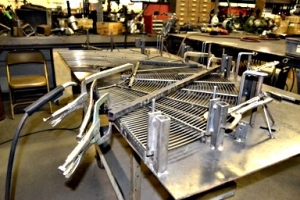A misconception in wire forms, is when people think of wire, they think of a piece of wire up to 200 thousandths diameter. Wire, in the world of manufacturing and professionals, is just about any size of a piece of round solid stock up to an 1 1/4 in diameter. We can bend wire up to an inch and a quarter diameter. In every diameter of wire you run into a limitation that you can bend wire no tighter. That changes by tinsel strength of the sub-straight itself. Hard tooling, CNC machinery, and secondary functions are an important part in co-manufacturing wire forms.
Hard Tooling Wire Forms & Project Requests
 If the wire forming request lends itself to what we call hard tooling, then that many times is something that we’ll use when there’s a large number of product desired. Hard tooling initially, is more expensive than programing a machine. We have to go and heat-treat, and make the tools to create the part. Once done, now these parts can be made more affordable.
If the wire forming request lends itself to what we call hard tooling, then that many times is something that we’ll use when there’s a large number of product desired. Hard tooling initially, is more expensive than programing a machine. We have to go and heat-treat, and make the tools to create the part. Once done, now these parts can be made more affordable.- If a person or company wants a lower number of parts, it doesn’t makes sense to put their money into the hard-tooling. Now we program the CNC (Computer Numerically Controlled) machine. A CNC machine will produce and form these parts. The next time your company needs more parts, the program is saved. The gauge, or the size of wire, is put on the machine to be formed.
If the capabilities of the machinery cannot produce exactly what’s needed, secondary functions become important in bending and forming. Not many people just want a wire form and be done with it.
The bulk of wire forms are made with 1008 and 1018 carbon contents. We are not limited to 1008 and 1018 carbon contents.
